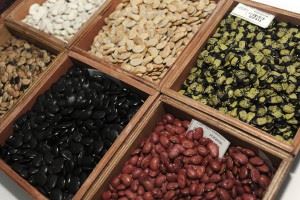Table of Contents
The food we eat keeps us strong and healthy. Food provides us with the nutrients and energy that we need for the proper functioning and growth of the body. As human beings are incapable of synthesizing food, we depend on plants and animals for our food. The population explosion has led to a greater demand for basic requirements such as food, shelter, clothing, etc. Another impact of population on food crop production is land exploitation. Thus, cultivation has been limited to a small area.
In order to meet the demands using limited resources, we need to apply a greater effort. Crop variety improvement, crop production improvement and crop protection management are three major ways to improve food crop production.
Let us have a look at food crops and different methods of crop variety improvement.
Also Read: Crops
Food Crops
Food crops are crops that contribute to the world’s major food supply. They comprise grains, seeds, nuts, vegetables, fruits, legumes, spices, herbs, beverages, etc.
Grains are a major source of human food. They serve as a staple food for the majority of the population. These include rice, wheat, maize and barley.
Legumes and dried beans have a longer shelf-life and are economical. Thus, they can be used in seasons when food is scarce. They are rich in proteins. Examples are kidney beans, chickpeas, green peas and peanuts.
Seeds and nuts are the powerhouses of energy and a concentrated form of food. Examples of nuts are cashew, badam, pistachio, brazil nuts and walnuts.
Herbs have a strong flavour. These mainly comprise leaves, stems, flowers, roots and seeds. E.g.: Coriander leaf
Methods Of Crop Variety Improvement
Crop variety improvement is the primary step to improve food crop production. It helps in the development of crops with desired traits such as high yields, disease resistance, quality product and response to fertilizers. We can raise different strains of food crops with desirable traits naturally as well as scientifically. Two of the scientific methods are as follows:
Hybridization
The crossing of genetically dissimilar plants is referred to as hybridization. Hybridization may take place between two different varieties of the same species (intervarietal), between two different species of the same genus(interspecific) or between different genera (intergeneric).
Gene Incorporation
Genes are responsible for the traits. Thus, we can improve crop quality and quantity by incorporating the genes with desirable traits. This method is more scientific and results in genetically modified food crops.

Crop production is more like a business in many countries. Thus, the strains we develop must be economically profitable. The new varieties should be able to produce maximum quality and quantity under different conditions and regions. Hence, we need to be very selective about seeds for their acceptance.
Also Read: Bt Crops
Why is Crop Variety Improvement Important?
We know resources are very limited, but the demand is very high. Thus, the basic reason for variety improvement is to meet the requirements. However, the quality and quantity of the crop produced shouldn’t be compromised due to the limited resource and present scenario. This is why scientists developed different varieties. The different strains should be able to show maximum productivity under any diverse conditions. This leads to the idea of improvement of food crop variety. 
The variety improvement is done for the following reasons.
Higher yield: Crop variety improvement’s main goal is to increase the productivity of the crop. The productivity is improved by producing high yielding varieties through plant breeding.
Quality product: To improve the quality of the food crops. The quality of the crop depends on the type of crop. Considering the pulses and grains, they must have better baking quality. Oil crops should give quality oil.
Resistance: To develop resistance to both living and non-living factors. Biotic factors like insects, parasites, diseases, etc. and abiotic factors like hot, cold, drought, salinity, etc. affect crop production. A resistant variety can withstand these factors and give a high yield.
Maturity period: To shorten and develop a uniform maturity period. The short maturity period of crops helps farmers in multiple rounds of cultivation in less expenditure during a short period. Also, the uniform maturity of crops helps in easy harvesting. Thus, the overall variety of improvements makes the situation more profitable.
Adaptation: To develop tolerance and make crops more adaptable to different conditions. The crops can be grown even in diverse conditions. For example, crops with tolerance to high salinity soil.
Desirable agronomic characteristics: To develop desired agronomic characteristics in crops. This helps in a higher yield in less expenditure. For example, dwarfness in cereals reduces nutrient consumption without affecting the yield.
Also Read: Improvement in Crop Yields
To know more about crop variety improvement and food crops production, visit BYJU’S website.
Frequently Asked Questions on Food Crops – Crop Variety Improvement
What is an example of gene incorporation in plant variety improvement?
Gene incorporation is used in the production of Bt brinjal. The plant is resistant to lepidopteran larvae. This is created by inserting the delta-endotoxin gene into the plant through the Ti plasmid.
Name high-yielding semi-dwarf varieties of wheat.
Sonalika and Kalyan Sona are high-yielding semi-dwarf varieties of wheat introduced in India.
Give an example of quality improvement.
Saccharum barberi and Saccharum officinarum were crossed to obtain sugarcane with quality of high sugar content and have the ability to grow in north India.

Comments